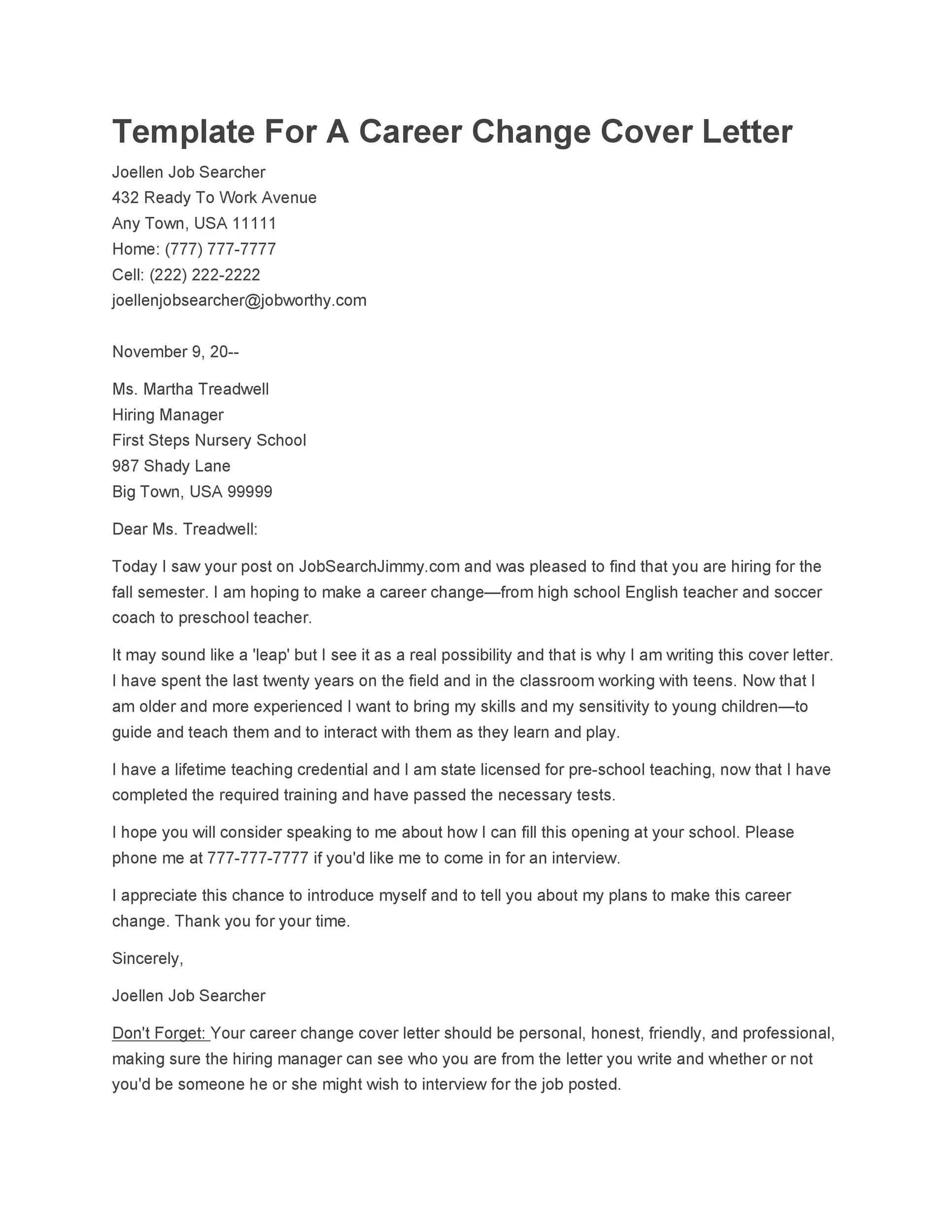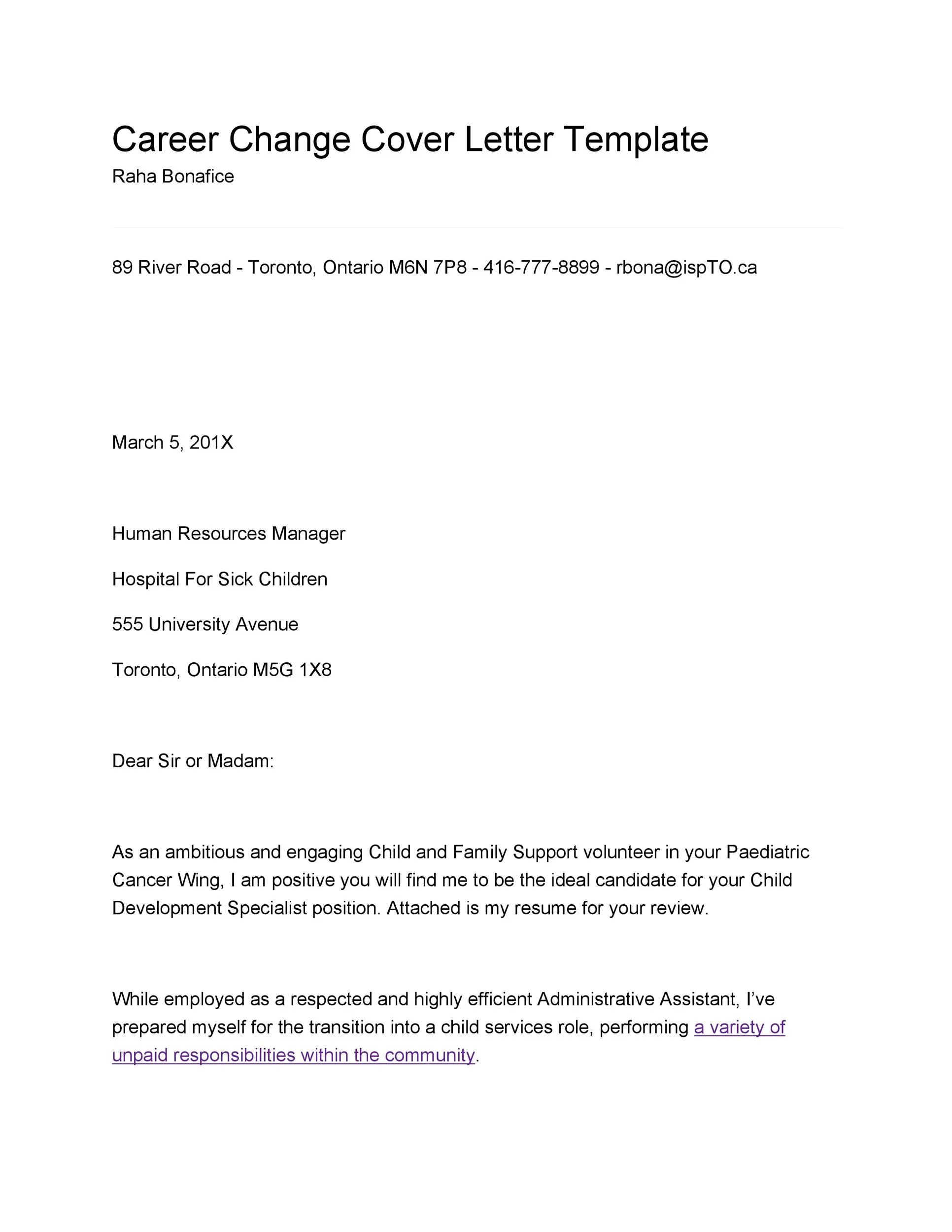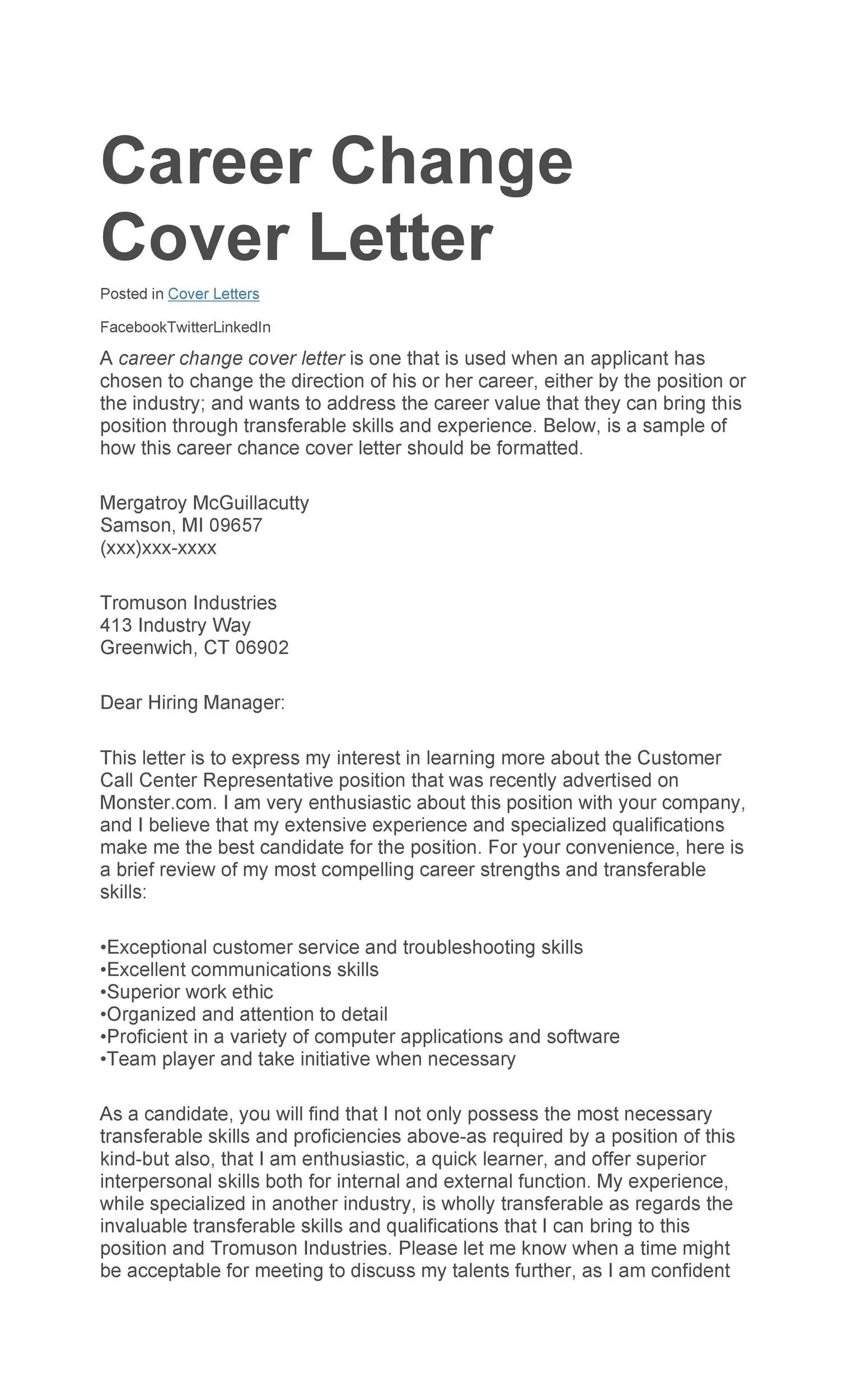What is a Career Change Cover Letter
A career change cover letter is a crucial document for anyone looking to transition to a new field. Unlike a standard cover letter that reinforces your experience within the same industry, this letter specifically addresses the shift in your career path. It serves as your opportunity to explain why you’re making this change, what relevant skills you bring, and how your past experiences align with the new role. This letter is designed to convince the hiring manager that your transferable skills and enthusiasm make you a valuable candidate, even without direct experience in the new field. It’s a way to proactively address potential concerns and highlight your adaptability and eagerness to learn.
Why is a Career Change Cover Letter Important
The importance of a career change cover letter cannot be overstated. It’s your first impression and a critical tool in overcoming the initial hurdle of a career shift. It allows you to proactively address the potential concerns a hiring manager might have about your lack of direct experience. The letter provides context for your resume, explaining the ‘why’ behind your career change and demonstrating your strategic thinking. It also showcases your ability to adapt and learn, qualities highly valued by employers. Furthermore, it gives you the opportunity to highlight your enthusiasm for the new role and industry, which can be a significant advantage over candidates with more direct experience but less passion.
Key Elements of a Career Change Cover Letter

A compelling career change cover letter needs to include specific elements to effectively convey your message. It starts with a clear and concise introduction that states the position you’re applying for and briefly highlights your career change. The body of the letter should focus on your transferable skills, quantifying your achievements from previous roles whenever possible. You must also address the career change directly and explain your motivations for the shift. The letter concludes with a strong closing paragraph, expressing your enthusiasm for the opportunity and a call to action. Each element must work in concert to paint a picture of a motivated, skilled, and adaptable candidate ready to excel in the new role.
Highlighting Transferable Skills
One of the most important sections is highlighting your transferable skills. These are the skills you’ve developed in previous roles that are also valuable in your desired new field. Identify these skills (communication, problem-solving, leadership, project management, etc.) and provide specific examples of how you’ve used them. Connect your past experiences to the requirements of the new role, demonstrating that you have the foundational abilities needed to succeed. For example, if you’re moving from marketing to project management, highlight your experience managing marketing campaigns, coordinating teams, and meeting deadlines to demonstrate relevant project management skills. Make sure these are skills that the new job has in its requirements.
Quantifying Achievements
Quantifying your achievements is critical for showcasing your value. Whenever possible, use numbers and data to illustrate your accomplishments. Instead of simply stating you ‘managed social media,’ provide specific results, such as ‘increased social media engagement by 30% in six months’ or ‘grew the social media following by 10,000 users’. This provides concrete evidence of your abilities and helps the hiring manager understand the impact you’ve made in previous roles. This demonstrates your ability to drive results and adds credibility to your claims. These achievements also help you stand out from other candidates who use general descriptions. Make sure these are specific numbers the company is looking for.
Addressing the Career Change

Directly address the career change in your cover letter. Explain your reasons for the shift and why you’re interested in this specific role and industry. Be honest and authentic, but frame your transition positively. Highlight your passion for the new field, your enthusiasm for learning new skills, and your commitment to the new career path. Share your research, your understanding of the new industry, and the specific ways you hope to contribute. Make sure to express your understanding and motivations. This will help ease any concerns the hiring manager may have about your lack of direct experience and demonstrate that your move is driven by genuine interest and strategic thought.
Structuring Your Cover Letter
The structure of your cover letter is as important as its content. A well-structured letter is easier to read and more persuasive. Make sure to follow a standard business letter format, with clear sections and a logical flow. Begin with a professional header, a formal salutation, and then proceed with an engaging opening paragraph, followed by body paragraphs that elaborate on your skills, experiences, and the reasons for your career change. Finish with a strong closing paragraph and a professional sign-off. A structured approach shows you pay attention to details.
Header and Salutation
The header of your cover letter should include your contact information (name, address, phone number, and email) and the date. If possible, address the hiring manager by name, researching their name online or checking the job posting. Use a formal salutation such as ‘Dear Mr./Ms. [Last Name]’ or ‘Dear Hiring Manager’ if you can’t find the name. Always use formal language in your header and salutation and make sure it’s appropriate for the organization and role.
Opening Paragraph

The opening paragraph should immediately grab the reader’s attention. Clearly state the position you are applying for and briefly mention where you saw the job posting. Follow this by a concise statement about why you are writing and how your career change aligns with the opportunity. Show enthusiasm for the role. This paragraph should also quickly capture the reader’s interest and set the stage for the rest of the letter.
Body Paragraphs
The body paragraphs are the core of your cover letter. Use these to delve into your transferable skills, experiences, and accomplishments. Each paragraph should focus on a specific skill or experience that relates to the job requirements. Provide specific examples and quantifiable results to demonstrate your value. Explain how your previous experiences have prepared you for the new role and why you’re passionate about the career change. Highlight the achievements you are proud of. Use active language to maintain reader engagement.
Closing Paragraph
The closing paragraph should reiterate your interest in the position and express your enthusiasm for the opportunity. Reiterate your value and the skills you would bring to the role. Include a call to action, such as expressing your availability for an interview or stating that you look forward to hearing from them. End with a professional sign-off, such as ‘Sincerely’ or ‘Best regards,’ followed by your name.
Formatting and Design

Formatting and design play a key role in the effectiveness of your cover letter. Use a professional, easy-to-read font, such as Arial or Times New Roman, in a readable size (11 or 12 points). Maintain consistent spacing and margins throughout the document. Keep the letter concise, aiming for no more than one page. Use bullet points, bolding, and white space to make the information easily digestible. A clean, well-organized letter conveys professionalism and attention to detail.
Tailoring Your Cover Letter
Tailoring your cover letter to each specific job is crucial for success. Generic cover letters are easily spotted and often discarded. Spend time researching the company and the role. Review the job description carefully, identifying the key skills and requirements. Then, tailor your cover letter to match these requirements, highlighting the relevant experiences and skills you possess. Show that you understand the company’s mission, values, and the specific challenges they are facing. Personalization demonstrates your genuine interest in the opportunity and increases your chances of getting noticed.
Researching the Company
Before writing your cover letter, thoroughly research the company you’re applying to. Visit their website, read their ‘About Us’ page, and explore their social media presence. Understand their mission, values, products, and services. Search for recent news articles or press releases about the company. This research will help you understand their culture and identify any current challenges or projects. This will allow you to tailor your letter to demonstrate your understanding of the company and how your skills align with their specific needs. Mention any relevant details you have found. This shows your interest.
Matching Skills to Requirements

Carefully review the job description and identify the required skills and qualifications. Create a table or a list where you match your skills and experiences with the requirements. Use the same keywords and phrases that the employer uses in the job description. This will help you demonstrate that you possess the necessary qualifications and that you’ve paid attention to the details of the role. Use specific examples to demonstrate how you have used these skills in the past. This targeted approach demonstrates that you are an ideal fit for the role.
Proofreading and Editing
Proofreading and editing are critical steps in ensuring your cover letter is polished and professional. Errors in grammar, spelling, or punctuation can undermine your credibility. After writing your cover letter, take the time to carefully proofread it multiple times. Use spell check and grammar check tools, but also read the letter aloud to catch any awkward phrasing or errors. Consider asking a friend, family member, or career counselor to review your letter and provide feedback. A fresh pair of eyes can often catch mistakes that you may have missed.
Common Mistakes to Avoid
Several common mistakes can significantly reduce the effectiveness of your career change cover letter. Avoid generic language; tailor each letter to the specific job. Don’t simply restate your resume; elaborate on your experiences and highlight your transferable skills. Don’t focus solely on your lack of direct experience; instead, emphasize your transferable skills, enthusiasm, and willingness to learn. Avoid negative language or excuses for your career change; frame it positively. Make sure not to exceed one page in length. Always proofread and edit carefully. A professional and well-crafted letter is more likely to get you an interview and ultimately help you get the new job.
